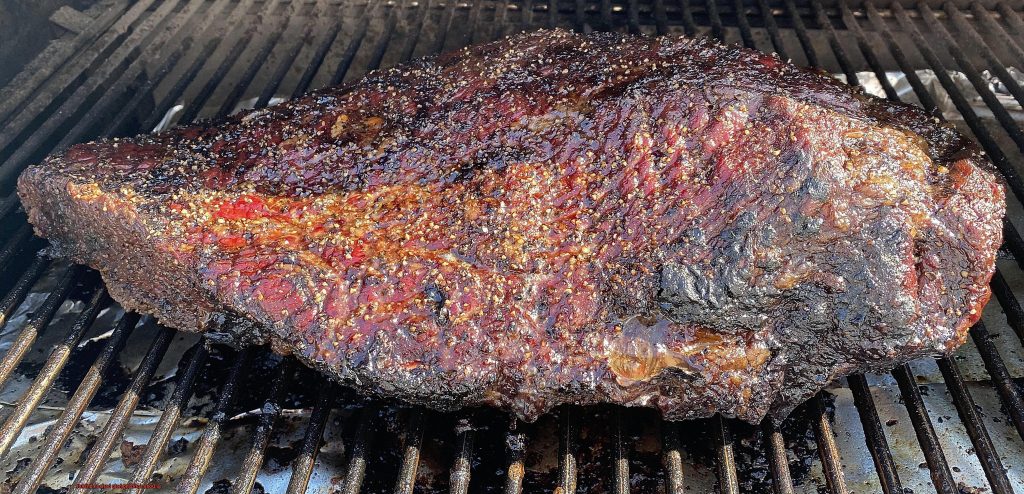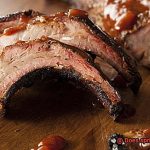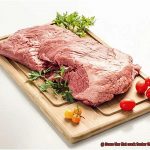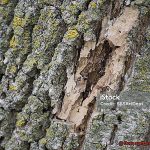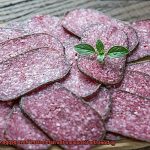Imagine this: a brisket so tantalizingly tender, it practically melts in your mouth. The intoxicating scent of smoky goodness wafting through your backyard, beckoning friends and family to gather ’round. For us barbecue aficionados, crafting the perfect brisket is an art form that requires time, patience, and a dash of culinary wizardry. But what about that coveted bark? That magical crust that envelops the meat, boasting a symphony of flavors that make your taste buds sing? If you’ve ever pondered whether spritzing could take your bark game to new heights, well my friend, you’re about to embark on an epic flavor adventure.
In this blog post, we’re diving headfirst into the age-old question: does spritzing help bark on brisket? We’ll be exploring the purpose behind this technique, unraveling the scientific wizardry at play, and uncovering how it can transform your brisket from good to mind-blowingly great.
So, grab your apron, fire up that grill like a boss, and get ready to unleash the full potential of your bark masterpiece.
Contents
What is Spritzing?
One technique that can take your barbecue skills to the next level is spritzing. In this article, we will delve into the art of spritzing, exploring how it keeps meat moist, enhances flavor, and contributes to the creation of a delectable bark.
Spritzing: Moisture and Flavor in Every Bite
Spritzing involves periodically spraying or brushing your brisket with a liquid during the cooking process. While its primary purpose is to keep the meat moist and prevent it from drying out, spritzing offers so much more. It infuses your meat with delightful flavors, resulting in mouthwatering barbecue masterpieces.
The Secrets Behind Spritzing:
- Moisture Retention: As meats cook, they naturally lose moisture. Spritzing replenishes that lost moisture, ensuring that your brisket stays juicy and tender throughout the cooking process.
- Flavor Infusion: The liquid used for spritzing can be customized to suit your taste preferences. Experiment with combinations of water, vinegar, fruit juice, or Worcestershire sauce to add a subtle hint of acidity or sweetness to your meat. These flavors penetrate deep into the meat, enhancing its overall taste.
- The Perfect Bark: The bark on brisket is what gives it that irresistible texture and intense flavor. Spritzing plays a key role in developing the coveted bark. As the liquid evaporates during cooking, it leaves behind concentrated flavors and sugars from the spritz mixture. This creates a rich and flavorful crust on the surface of the meat.
How to Spritz Like a Pro:
- Choose Your Liquid: Start with a base of water or vinegar, then get creative by adding your choice of fruit juice or other flavorful liquids. Experimentation is key here – find combinations that complement your taste preferences.
- Spritzing Tools: Invest in a dedicated spray bottle or mister for spritzing. These tools ensure an even distribution of the liquid onto the meat. Remember to clean them thoroughly after use to avoid cross-contamination.
- Spritzing Frequency: Aim to spritz your brisket every 30 minutes to an hour, depending on personal preference and the cooking method being used. This allows for consistent moisture and flavor infusion throughout the cooking process.
What is Bark on Brisket?
If you’re a fan of smoky, tender, and flavorful brisket, then you’ve probably heard about the legendary “bark.” But what exactly is it, and how can you achieve that perfect bark on your brisket? Look no further – we’re here to unveil the secrets behind this mouthwatering phenomenon.
What is Bark on Brisket?
Bark on brisket refers to the delectable outer crust that forms during the smoking process. It’s like a culinary masterpiece – a tantalizing combination of flavors, textures, and visual appeal. The bark is created through a magical dance between the meat’s natural juices, spices, smoke, and heat.
The Science Behind It:
When you smoke a brisket, something extraordinary happens on the surface of the meat. Proteins undergo a chemical reaction known as the Maillard reaction, resulting in browning and the development of complex flavors. Sugar and amino acids unite to create new compounds that give the bark its distinctive taste and color. And let’s not forget about the role smoke plays – it adds depth and complexity to the flavor profile.
The Protective Shield:
But the bark isn’t just for show; it also serves a practical purpose. As the brisket smokes away, the bark acts as a protective layer that seals in moisture and prevents excessive evaporation. This means your final product will be juicier and more tender. And let’s not forget that satisfying contrast between the crispy exterior and melt-in-your-mouth interior.
The Power of Spritzing:
Now that we understand what bark is all about, let’s talk about spritzing – an essential technique to master if you want to elevate your bark game. Spritzing involves periodically spraying or misting your brisket with a liquid during smoking. This technique provides two significant benefits:
- Flavor Infusion: When you apply liquid to the surface of the meat, it dissolves any residual rub or spice mixture, allowing for better smoke penetration and even flavor distribution throughout the meat. It’s like giving your brisket a flavor boost from the inside out.
- Moisture Maintenance: As moisture evaporates from the surface, it cools down and condenses, creating a more humid environment around the meat. This prevents excessive drying and helps develop that coveted bark.
Experiment and Discover:
While spritzing is a valuable technique, remember that it’s not the only factor in bark formation. Temperature control, smoking duration, and wood selection also play significant roles. So, fire up your smoker, grab your spritzer bottle, and embark on a delicious journey of trial and error to find what works best for you.
Pros and Cons of Spritzing for Bark Formation
Brisket bark formation is a crucial aspect of achieving a flavorful and tender final product. Spritzing, the act of spraying a liquid onto the meat during cooking, has been a subject of debate among grill enthusiasts. In this article, we will explore the pros and cons of spritzing for bark formation on brisket to determine its effectiveness.
Pros of Spritzing for Bark Formation:
- Moisture Magic: Spritzing helps retain moisture in the brisket during the low and slow cooking process. By injecting liquids like apple juice or vinegar, the meat stays moist, resulting in a juicy and tender end product.
- Flavor Fiesta: Spritzing is not just about moisture; it can also enhance the flavor profile of the brisket’s bark. Infusing the meat with barbecue sauce, marinade, or homemade concoctions creates a flavor explosion that tantalizes taste buds.
Cons of Spritzing for Bark Formation:
- Seasoning Sacrifice: Excessive spritzing can wash away the flavorful rub or seasoning applied to the brisket, potentially leading to a less pronounced or flavorful bark. Achieving a balance between adding moisture and preserving seasoning is crucial.
- Cooking Time Conundrum: Opening the smoker or grill to spritz releases heat and smoke, which can extend the cooking time. Patience is essential while spritzing to avoid prolonging the cooking process.
- Texture Tango: The moisture from spritzing can soften or minimize the desired crunchy bark texture. Experimentation with different spritzing techniques and liquids is necessary to strike the perfect balance between moisture and mouthfeel.
The Role of Dry Rubs in Bark Formation
Imagine sinking your teeth into tender, juicy meat, encased in a caramelized crust bursting with flavor. Are you ready to embark on this flavorful journey? Let’s dive in.
The Power of the Dry Rub:
A dry rub is a magical blend of spices that transforms your brisket into a flavor-packed masterpiece. It’s like giving your meat a big, flavorful hug before it hits the grill. But what exactly does it do?
Enhancing Flavor and Texture:
The beauty of a dry rub lies in its ability to penetrate the meat and enhance its natural flavors. It’s an orchestra of spices, working together to create a symphony of taste. From the earthy warmth of paprika to the tantalizing kick of garlic powder, each ingredient plays its part, adding depth and complexity.
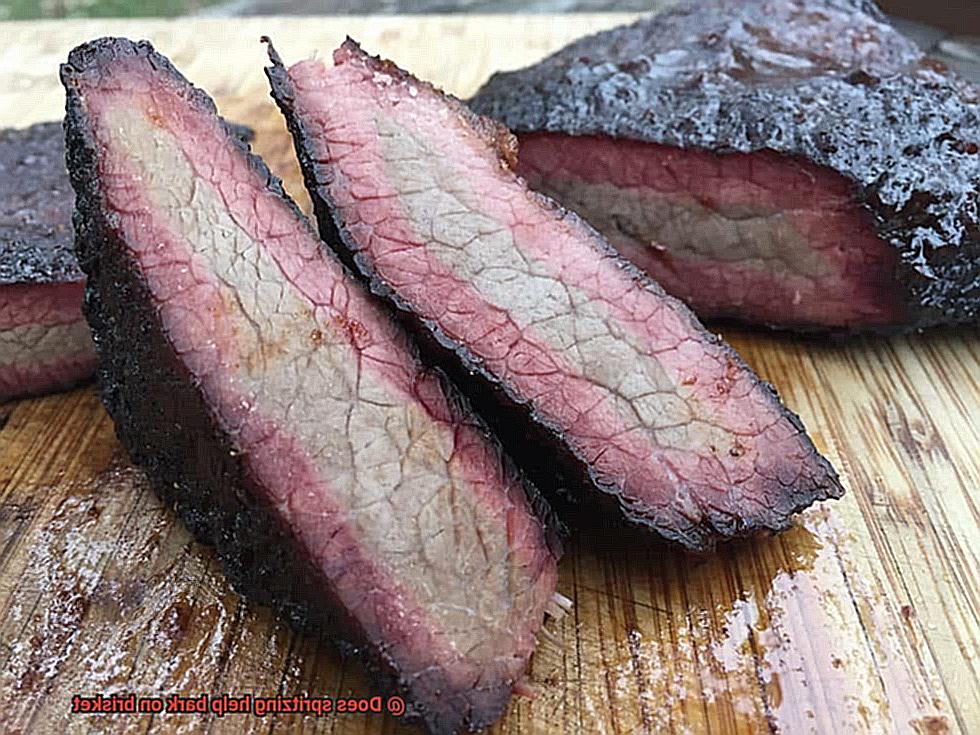
Creating the Coveted Bark:
Now, brace yourself for the real magic – bark formation. The dry rub acts as a catalyst, creating that irresistible crust on the exterior of your brisket. As it cooks, the combination of spices and seasonings melds with the meat’s juices, resulting in a savory flavor explosion that will leave you craving for more.
The Perfect Dry Rub Recipe:
While there are endless possibilities when it comes to dry rub ingredients, let’s touch on some classics that never fail to impress. Salt and pepper form the foundation for balanced seasoning. Add in paprika for color and smokiness, garlic powder for depth, onion powder for a touch of sweetness, and perhaps a hint of cayenne pepper for some heat. Feel free to experiment and make it your own.
Moisture Retention:
Dry rubs not only provide flavor but also help retain moisture during cooking. Initially, the salt draws out moisture from the meat, but as it cooks, it forms a protective barrier, sealing in those precious juices. Say goodbye to dry and bland brisket – hello, succulence.
Collaboration is Key:
While dry rubs are essential, remember that they work in harmony with other factors in bark formation. Smoke exposure, temperature control, and cooking time all play significant roles. So, keep experimenting and perfecting your craft.
The Impact of Smoke on Bark Formation
Enter the smoky realm of grilling, where the tantalizing secret behind creating that irresistible bark on your brisket unfolds. Imagine sinking your teeth into a slice of perfectly smoked, tender, and flavor-packed meat. But how exactly does smoke work its enchantment on bark formation? Let’s delve into the magical world of smoke and its impact on the creation of that delectable bark.
The Maillard Reaction:
Embarking on the journey to bark perfection, we encounter the Maillard reaction. As smoke gracefully envelops your brisket, a chemical symphony takes place. Complex organic compounds from wood combustion dance with proteins and sugars on the meat’s surface. This intricate interaction triggers the Maillard reaction, responsible for the browning and flavor development in various foods, including our beloved brisket.
The Formation of Bark:
Combining heat and aromatic compounds, smoke orchestrates the creation of a crust-like layer on the brisket’s surface – the legendary bark. This dark brown or black coating not only adds a visually stunning touch but also delivers a punch of smoky goodness that elevates the overall taste experience to ethereal heights.
Preserving Moisture:
But there’s more to this enchanting tale. Smoke possesses a natural preservative quality, weaving a protective barrier on the meat’s surface. This barrier ensures moisture retention and prevents excessive evaporation during cooking. The result? A tender and juicy final product that beckons you to take another heavenly bite.
Wood Selection:
Selecting the right wood for smoking is akin to choosing a wand for your culinary magic. Each type of wood imparts its own distinct flavor to your brisket, enhancing the complexity of the bark. Whether you opt for hickory’s robust smokiness or the sweet subtlety of apple or cherry wood, each choice brings its own unique charm to your brisket masterpiece.
The Art of Spritzing:
Ah, spritzing – a technique that can make or break your bark formation. Spritzing involves periodically misting or spraying liquid onto the brisket during cooking. While it helps keep the meat moist, it can also impact the development of the bark. A spritz of water or apple juice creates a humid environment, resulting in a softer crust. Conversely, using a liquid containing sugars can enhance caramelization, adding depth and complexity to the bark’s flavor profile.
Finding Your Perfect Balance:
As with any culinary art, finding the right balance is key. Too much smoke can overpower the flavor or introduce bitterness, while excessive spritzing may sacrifice bark development. Experimentation and personal preference play vital roles in achieving your desired outcome – a harmonious symphony of smoke, bark, and flavor.
The Maillard Reaction and Its Role in Bark Formation
Today, we embark on a flavorful journey into the realm of brisket bark formation. Brace yourselves, for we shall unravel the secret behind that awe-inspiring crust that makes your taste buds tango with delight. Get ready to dive into the world of the Maillard Reaction and discover how spritzing can either make or break this magical process.
The Maillard Reaction: A Symphony of Flavor:
Imagine the sizzling sound as your brisket hits the grill, its surface temperature rising to a tantalizing 300°F (149°C). It is at this moment that the Maillard Reaction begins its symphony. Like an orchestra, amino acids and reducing sugars in the meat join forces under the heat’s command. Their harmonious dance creates a medley of new compounds, unveiling the rich flavors and inviting aromas that we crave.
Spritzing: The Wand for Culinary Magic:
Now, let’s talk spritzing – your culinary wand for shaping that perfect bark. Spritzing involves misting the brisket’s surface with a liquid elixir like water, vinegar, or fruit juice. Its purpose? To maintain moisture levels during cooking and potentially enhance the Maillard Reaction for an even more tantalizing bark.
The Balance Game:
Ah, the delicate balance between moisture and flavor. Spritzing can be a double-edged sword in bark formation. On one hand, it keeps your brisket moist, preventing premature drying and allowing the Maillard Reaction to work its magic over an extended period. This results in a more pronounced and flavorful bark.
But beware. Too much spritzing or using liquids high in sugar or acid content can tip the balance unfavorably. Excessive moisture can create a barrier that inhibits browning, leaving you with a lackluster bark. And if your spritzing liquid is too sugary, you risk ending up with a sticky and overly sweet bark that deviates from the desired smoky goodness.
Mastering the Art of Spritzing:
To achieve brisket perfection, we must find the elusive sweet spot in spritzing. Here are some tips to guide you:
- Choose the Right Liquid: Opt for a primarily water-based spritzing liquid with minimal sugar or acid content. This allows moisture retention without hindering the browning process.
- Less is More: Remember, less is more – a light spritz ensures a moist surface without saturating it. Aim for a fine mist rather than drenching the meat.
- Timing is Key: Spritzing should be done periodically throughout the cooking process. Too early, and you risk losing moisture too quickly; too late, and the Maillard Reaction may have already reached its peak.
Different Pitmasters’ Views on Spritzing
Spritzing, the act of spraying or misting liquid onto meat during the smoking or grilling process, is a hotly debated topic among pitmasters. Let’s explore the contrasting views on this grilling technique.
Some pitmasters are firm believers in spritzing. They argue that it helps develop a better bark on brisket by keeping the meat moist and enhancing flavor. Spritzing prevents the meat from drying out and forming a tough crust while ensuring a more even flavor throughout. The moisture from the spritz also helps dissolve and distribute the rub, resulting in a more flavorful final product. Additionally, using flavorful liquids like apple juice, vinegar, or bourbon in the spritz can add an extra layer of deliciousness to the bark.
On the flip side, some pitmasters believe that spritzing can hinder bark formation. They argue that constantly opening the smoker or grill to spritz the meat allows heat and smoke to escape, leading to longer cooking times and potential flavor loss. These pitmasters prefer to let the natural juices and rendered fat from the brisket work their magic in creating a flavorful and crispy bark. They believe that maintaining a consistent cooking environment without interruption is key.
Ultimately, whether to spritz or not is a matter of personal preference and experimentation. Factors such as cooking technique, smoker or grill type, and individual taste preferences all influence a pitmaster’s view on spritzing. Finding the delicate balance between moisture and flavor is crucial to mastering this magical process of bark formation.
Experimenting with Different Techniques to Form a Desirable Bark
When it comes to grilling a mouthwatering brisket, one thing stands above all else – the bark. That irresistible, caramelized crust that forms on the outside of the meat is what elevates a good brisket to greatness. But how do you achieve that coveted bark? The answer lies in experimenting with different techniques.
The Great Spritzing Debate:
Spritzing, the act of misting or spraying the brisket with liquid during the cooking process, has sparked a fiery debate among pitmasters. On one side, we have spritzing enthusiasts who swear by its ability to keep the brisket moist and infuse it with delectable flavors. On the other side, we have purists who believe that spritzing hinders bark formation by interrupting the cooking process.
Techniques to Try:
To settle this debate once and for all, it’s time to roll up our sleeves and get experimental. Here are some techniques you can try to find your perfect brisket bark:
Water Spritzing:
Start with the basics by spritzing your brisket with water. This neutral liquid will keep the surface moist without altering its flavor. Experiment with different spritzing intervals, such as every 30 minutes, to find what works best for you.
Flavorful Liquid Spritzing:
For those seeking an extra burst of flavor, try spritzing your brisket with apple juice, vinegar, or even bourbon. These liquids add a tangy or sweet taste to the bark while keeping it moist. Get creative and mix different liquids together to find your desired flavor profile.
Spritzing Intervals:
Some pitmasters swear by starting with frequent spritzes at the beginning of the cooking process and tapering off towards the end. Others prefer a consistent spritz throughout. Experiment with different intervals and see which gives you the best results.
Remember the Variables:
While spritzing is an important factor in bark formation, don’t forget to consider other variables. The type of wood used for smoking, temperature control, cook duration, and the rub or seasoning applied to the brisket all play a role in creating that perfect bark.
Conclusion
Spritzing, the act of spraying liquid onto the surface of a brisket while it is cooking, has long been debated among pitmasters. Some swear by it, claiming that it helps to develop a beautiful and flavorful bark on the outside of the meat. Others dismiss it as unnecessary, arguing that a good bark can be achieved without spritzing.
But what does the science say? Well, there isn’t a definitive answer. The truth is that spritzing can have varying effects on the bark depending on several factors such as temperature, humidity, and the type of liquid used.
When you spritz a brisket with water or another liquid, it can help to keep the surface moist and prevent it from drying out too quickly. This prolonged exposure to moisture can result in a softer bark that lacks the desired texture and crunch. On the other hand, some pitmasters believe that spritzing with certain liquids like apple juice or vinegar can enhance the flavor profile of the bark.
Ultimately, whether or not spritzing helps develop a better bark on brisket comes down to personal preference. It’s worth experimenting with different techniques to find what works best for you. Remember, achieving a delicious bark is about finding the right balance between moisture and dryness while allowing enough time for the flavors to develop.
So next time you fire up your smoker and prepare a mouthwatering brisket, consider giving spritzing a try. You might just discover a new technique that takes your barbecue game to another level.

